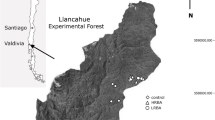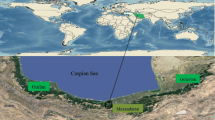Abstract
• Introduction
This study presents a method for estimating the minimum area which exhibits a balanced diameter distribution, and the corresponding number of trees, for different tree species and forest types in the Santiago Papasquiaro region in the State of Durango, Mexico. The balanced structure area is defined as the minimum contiguous area that is required for sustainable management of a multi-sized selection forest. A multi-sized forest represents a balanced structure unit if the relationship between harvest and growth can be maintained, using a defined target diameter distribution and disregarding major natural disturbances. The study is based on 17,577 sample plots in uneven-aged forests, which are selectively harvested by local communities.
• Results and discussion
The minimum structure areas that provide a balanced diameter distribution in the diameter at breast height (DBH) interval of 12 to 57 cm vary from 0.4 to 122 ha, depending on the particular tree species. This study has shown that it is possible to identify silvicultural treatments that are conducive to sustainable use.
• Conclusion
Future management monitoring in the unique forests of Durango will reveal unsustainable harvesting practices more effectively and in a more comprehensive way than before, using the methods presented in this study.



Similar content being viewed by others
References
Baker JB, Cain MD, Guldin JM, Murphy PA, Shelton MG, (1996) Uneven-aged silviculture for the loblolly and shortleaf pine forest cover types, United States Department of Agriculture, Forest Service, Southern Research Station, Gereral Technical Report SO-118, p 65
Bücking W (2003) Are there threshold numbers for protected forests? J Environ Manage 67:37–45
Buongiorno J, Gilles JK (2003) Decision methods for forest resource management. Academic, San Diego, p 439
Cancino J, Gadow Kv (2002) Stem number guide curves for uneven-aged forests - development and limitations, In: Gadow Kv, Nagel J, Saborowski J 2001. Continuous Cover Forestry—Assessment, Analysis, Scenarios, Kluwer
Corral-Rivas JJ (2006) Models of tree growth and spatial structure for multi-species, uneven-aged forests in Durango (Mexico), PhD thesis, University of Göttingen
Corral-Rivas JJ, Sánchez S, Kotze H, Gadow K (2009) Testing the suitability of the Nepal-Somers stand table projection method for Eucalyptus grandis plantations in South Africa. Southern Forests: J For Sci 71(3):207–214
FAO (1998) http://www.fao.org/UNFAO/Bodies/NAFC/nafc98/NAFC4-E.HTM
Frankham R (1996) Relationship of genetic variation to population size in wildlife. Conserv Biol 10(6):1500–1508
Gadow Kv, Hui GY (2007) Can the tree species-area relationship be derived from prior knowledge of the tree species richness? Forest Stud Metsanduslikud Uurimused 46:13–22
Gadow Kv, Puumalainen J (2000) Scenario planning for sustainable forest management. In: Gadow Kv, Pukkala T, Tomé M (eds) Sustainable forest management. Kluwer Academic Publisher, Dordrecht, pp 319–356
García E (1989) Modificaciones al sistema de clasificación climática de kôpen (para adaptarlo a las condiciones de la República Mexicana). Offset Larios, México D.F., 165
Goff FG, West D (1975) Canopy-understory interaction effects on forest population structure. For Sci 21:98–108
Gregorius HR, Degen B, König A (2007) Problems in the analysis of genetic differentiation among populations - a case study in Quercus robur. Silvae Genet 56:190–199
Guldin JM (1991) Uneven-aged BDq regulation of Sierra Nevada mixed conifers. West J Appl For 6(2):27–32
Hubbell SP (2001) The unified neutral theory of biodiversity and biogeography. Princeton University Press, Princeton
Koop H (1981) Vegetatiesstructuur en dynamiek van twee natuurlijke bossen: het Neuenburger en Hasbrucher Urwald, Verslagen van landbouwkundige onderzoekingen 904 PUDOW Wageningen
Koop H (1989) Forest dynamics-SILVI-STAR: a comprehensive monitoring system. Springer, Berlin
Korpel S (1982) Degree of equilibrium and dynamical changes of the forest in example of natural forests of Slovakia. Acta Fac For 24:9–13
Kotwal PC, Omprakash MD, Kandari LS, Mali KP, Badyal M, Mishra A (2008) Sustainable forest management through community participation. Curr Sci 95(8):1015–1017
Kurth H (1994) Forsteinrichtung. Nachhaltige Regelung des Waldes, Deutscher Landwirtschaftsverlag. Berlin, p. 592
Lawton JH (1999) Are there general laws in ecology? Oikos 84(2):177–192
Meyer HA (1933) Eine mathematische Untersuchung über den Aufbau des Plenterwaldes. Schweiz Z Forstwes Zürich 84:33, 88, 124
Nunney L, Campbell KA (1993) Assessing minimum viable population size: demography meets population genetics. Trends Ecol Evol 8:234–239
Nyland RD (2002) Silviculture. Concepts and applications, 2nd edn. McGraw-Hill, New York
Rajora OP (1999) Genetic biodiversity impacts of silvicultural practices and phenotypic selection in white spruce. Theor Appl Genet 99:954–961
Rodríguez CR (1958) Discusión de fórmulas para el cálculo de la productividad maderable y exposición del Método Mexicano de Ordenación de Montes de especies coníferas, Monografía Ftal. del Edo. de Michoacán, Comisión Ftal. del Estado, p 245
Rzedowski J (1978) Vegetación de México. Limusa, México
Schütz JP (2002) Silvicultural tools to develop irregular and diverse forest structures. Forestry 75:329–337
Schütz JP (2006) Modelling the demographic sustainability of pure beech plenter forests in Eastern Germany. Ann For Sci 63:93–100
Secretaría de Recursos Naturales y Medio Ambiente (SRNyMA) (2002) Programa Estratégico Forestal 2030, Secretaría de Recursos Naturales y Medio Ambiente del Estado de Durango. Durango, Dgo., p 242
Seymour RS, Kenefic LS (1998) Balance and sustainability in multi-aged stands: a northern conifer case study. J Forest 96:12–17
Silva-Flores R, Hernández-Díaz P, Corral-Rivas JJ, Wehenkel C, Vargas-Larreta B (2010) Species-specific abundance, tree diversity and its relationship to climate factors in mixed and uneven-aged forests of Durango, Mexico. In: Kleinn C, Fehrmann L (eds) Proceedings of the Workshop “Forests in climate change research and policy: The role of forest management and conservation in a complex international setting. Göttingen, Germany, pp. 70–77
Thoms CA, Betters DR (1998) The potencial for ecosytems management in Mexico's forest ejidos. For Ecol Manage 103:149–1179
Tjørve E (2003) Shapes and functions of species-area curves: a review of possible models. J Biogeogr 30:827–835
Torres RJM (2000) Sostenibilidad del volumen de cosecha calculado con el método de ordenación de montes. Madera y Bosques 6(2):57–72
Vargas LB (2006) Analyse und Prognose des Einzelbaumwachstums in Strukturreichen Mischbeständen in Durango, Mexiko, PhD thesis Univ. Göttingen, p 173
Westphal C, Tremer N, Oheimb vG, Hansen J, Gadow vK, Härdtle W (2006) Is the reverse J-shaped diameter distribution universally applicable in European virgin beech forests? For Ecol Manage 223(1–3):75–83
Williams MR (1995) An extreme-value function model of the species incidence and species-area relationship. Ecology 76:2607–2616
Wright S (1938) Size of population and breeding structure in relation to evolution. Science 87:430–431
Acknowledgments
This study was generously supported by El Fondo de Cooperación Internacional en Ciencia y Tecnología entre la UE-México (project: 92739). We gratefully acknowledge the support offered by the technical directorate of the Ejido “San Diego de Tezains” who provided the data for this study.
Author information
Authors and Affiliations
Corresponding author
Additional information
Handling Editor: David E. Hibbs
Rights and permissions
About this article
Cite this article
Wehenkel, C., Corral-Rivas, J.J., Hernández-Díaz, J.C. et al. Estimating balanced structure areas in multi-species forests on the Sierra Madre Occidental, Mexico. Annals of Forest Science 68, 385–394 (2011). https://doi.org/10.1007/s13595-011-0027-9
Received:
Accepted:
Published:
Issue Date:
DOI: https://doi.org/10.1007/s13595-011-0027-9




